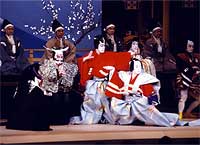|
|
|||||||
|
|
|||||||
|
|||||||
| | Web Japan >> | Trends in Japan >> | Arts & Entertainment >> | Kabuki, A World Treasure | |
|
KABUKI, A WORLD TREASURE Traditional Drama Gains UNESCO Designation (January 26, 2006) Kabuki, a traditional form of Japanese theater that originated about 400 years ago, was designated a Masterpiece of the Oral and Intangible Heritage of Humanity by the United Nations Educational, Scientific and Cultural Organization in November 2005. Kabuki is the third traditional Japanese performing art to receive this designation, after noh drama, which was chosen in 2001, and ningyo johruri bunraku, traditional Japanese puppet theater, selected in 2003. Kabuki Stagecraft After World War II a growing number of kabuki performances were staged overseas, and the genre became known as a "traveling ambassador" for its role in promoting international goodwill. The stylized gestures and movements of the actors, the presence of onnagata (male actors who specialize in female roles), and other unique elements of this drama have won it many fans outside Japan. In 2004 the popular kabuki actor Nakamura Kanzaburo enthralled New York audiences with his performances. UNESCO's intangible cultural heritage program complements its World Heritage designation, which aims to safeguard historical buildings and natural sites. Traditional arts, dances, rituals, festivals, and other forms of artistic expression are registered in accordance with the Convention for the Safeguarding of the Intangible Cultural Heritage, which was adopted during a UNESCO General Conference in 2003 with the aim of protecting cultural traditions and handing them down to future generations. The convention needs to be ratified by 30 countries to come into force. Classic Kabuki to be Protected The convention is expected to be ratified shortly. When this happens, a Representative List of the Intangible Cultural Heritage of Humanity will be created, and the intangible assets included in the proclamations will be transferred to the list. Attempts have been made to fuse kabuki with Western and contemporary theater, and kabuki-style performances of Shakespeare and works by contemporary playwrights are now undertaken. However, UNESCO has limited its designation to classical kabuki staged with traditional performance techniques. According to the Japanese media, the judges explained that while the introduction of Western acting styles may give rise to a process of creative evolution, it also carries the risk of bringing about a decline of the traditional art. In a press conference, Nakamura Jakuemon, a kabuki actor who has been designated a Living National Treasure by the Japanese government and serves as the chairman of the Organization for the Preservation of Kabuki, stated, "This designation is an unexpected joy for everyone involved with kabuki. I would like to use it as an opportunity to join hands with those involved in noh theater and bunraku to work for the development of our country's traditional culture." Copyright (c) 2006 Web Japan. Edited by Japan Echo Inc. based on domestic Japanese news sources. Articles presented here are offered for reference purposes and do not necessarily represent the policy or views of the Japanese Government. |
KABUKI MEETS SHAKESPEARE (August 11, 2005) PUPPET MASTERPIECE (January 14, 2004) |
|
|



